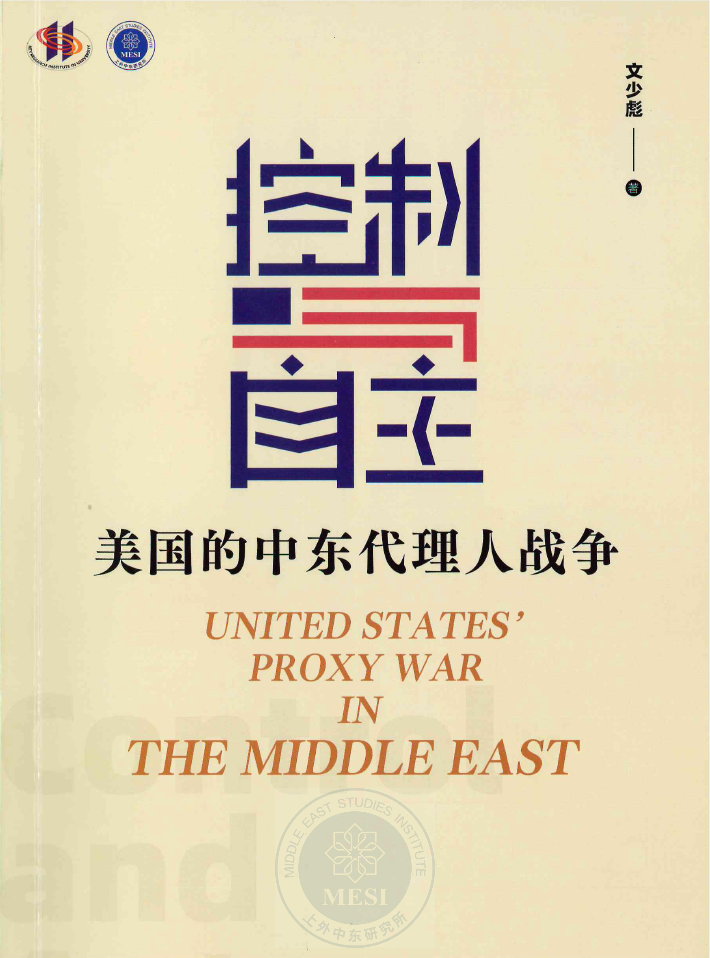
INFORMATION
NAME: UNITED STATES’ Proxy War in the Middle East
AUTHOR: Wen Shaobiao
PUBLISHER: China Social Science Press
PUBLISHING DATE: July 2023
ISBN:9787522719245
INTRODUCTION
After the September 11 incident, the Bush administration tried to use large-scale military force to transform the order in the Middle East. However, it backfired. Anti Americanism, terrorism and extremism in the Middle East spread wantonly, causing the United States to be mired in the Arab–Israeli War. The Obama administration took office and quickly adjusted its predecessor's Middle East policy, vigorously promoting the contraction of the Middle East strategy. The Trump and Biden administrations basically followed this direction. Currently, the United States is increasingly focusing on the Indo Pacific strategy and major country competition, continuously reducing strategic resource investment in the Middle East. In this context, the United States turned to rely on the alliance partner network in the Middle East to play its role, and the logic of the Proxy war was activated, that is, to incite, support or guide agents to intervene in the conflict of the target country, while the United States only participated in a small part of the actual combat, and maintained a slight footprint in the wide range of regional conflicts by behind the scenes leadership.
In the past 20 years, especially since the turmoil in West Asia and North Africa, the United States has operated Proxy war in Iraq, Libya, Syria, Yemen and other Middle East countries with different depths and scales, trying to save the hegemony in the Middle East with lower visibility and cost. However, once the Proxy war started, it caused competition between various forces inside and outside the region, which led to the prevalence of unconventional and small-scale conflicts. The parties involved in the conflict fell into a protracted melee, which seriously eroded the political and security order in the Middle East. Especially when non-state agents are empowered by external agents, they often seek independent interests, exacerbating the difficulty of controlling agency relationships. This book will systematically analyze the two-way game between the United States and local agents in the Middle East and the root cause of the collapse of the U.S. Proxy war in the Middle East, combining history, theory and cases.
AUTHOR
Wen Shaobiao is an assistant researcher of the Middle East Studies Institute of Shanghai International Studies University. He graduated with a PhD in International Relations from the School of International Relations and Public Affairs at Fudan University. Previously worked at the Taiwan Research Center of Fudan University as an assistant director. Also serving as a director of the Shanghai Taiwan Research Association. The main research areas include the Middle East issue, the United States issue, and the Taiwan Strait issue. In recent years, more than 10 academic journals in both Chinese and English have been published, and more than 20 media commentary articles have been published. Led one school level project, one horizontal project in Shanghai, and participated in multiple national and provincial level projects.
Table of Contents
Chapter 1 Analysis of the Connotation of Proxy War
Section 1 Proxy War Mode
Section 2 Endogenous Characteristics of Proxy War
Section 3: Differences between Agency Relations and National Alliances
Section 4 Re conceptualization of Proxy War
Summary of This Chapter
Chapter 2 General Interpretation of the Outbreak of Proxy War
Section 1 Power Competition Perspective
Section 2 Risk Avoidance Perspective
Section 3 Perspectives on Imputation
Section 4 Alternative Perspective
Summary of This Chapter
Chapter 3 Theoretical Analysis of Controlling Agent Autonomy
Section 1 Agent Autonomy
Section 2 Core Dimension: Benefits
Section 3 Incentive Dimensions
Section 4 Supervision Dimension
Section 5 Analysis Framework, Case Selection, and Research Ideas
Summary of This Chapter
Chapter 4: Suppression of the Al Qaeda Rebellion in Iraq: US Army Anbar Tribe (2006-2014)
Section 1: From Anti-US to United States: The Formation of Agency Relations
Section 2 Benefit Differentiation and Negative Incentive
Section 3 Information Asymmetry: Deviation of the Anbar Tribe
Summary of This Chapter
Chapter 5: Questioning the Subversion of the Assad Regime: The United States Syrian Rebellion (2011-2019)
Section 1: Misalignment of Interests between the United States and Opposition Agents
Section 2: The United States Gets into a Dilemma of Incentives and Supervision
Section 3 Uncontrollable Consequences: Deviation of Opposition Agents
Summary of This Chapter
Conclusion
References